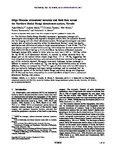Oligo‐Miocene extensional tectonics and fluid flow across the Northern Snake Range detachment system, Nevada
| dc.contributor.author | Gébelin, A | |
| dc.contributor.author | Mulch, A | |
| dc.contributor.author | Teyssier, C | |
| dc.contributor.author | Heizler, M | |
| dc.contributor.author | Vennemann, T | |
| dc.contributor.author | Seaton, NCA | |
| dc.date.accessioned | 2017-03-14T15:24:22Z | |
| dc.date.available | 2017-03-14T15:24:22Z | |
| dc.date.issued | 2011-10 | |
| dc.identifier.issn | 0278-7407 | |
| dc.identifier.issn | 1944-9194 | |
| dc.identifier.uri | http://hdl.handle.net/10026.1/8622 | |
| dc.description.abstract |
<jats:p>The Northern Snake Range (Nevada) represents a spectacular example of a metamorphic core complex and exposes a complete section from the mylonitic footwall into the hanging wall of a fossil detachment system. Paired geochronological and stable isotopic data of mylonitic quartzite within the detachment footwall reveal that ductile deformation and infiltration of meteoric fluids occurred between 27 and 23 Ma. <jats:sup>40</jats:sup>Ar/<jats:sup>39</jats:sup>Ar ages display complex recrystallization‐cooling relationships but decrease systematically from 26.9 ± 0.2 Ma at the top to 21.3 ± 0.2 Ma at the bottom of footwall mylonite. Hydrogen isotope (<jats:italic>δ</jats:italic>D) values in white mica are very low (−150 to −145 ‰) within the top 80–90 m of detachment footwall, in contrast to values obtained from the deeper part of the section where values range from −77 to −64 ‰, suggesting that time‐integrated interaction between rock and meteoric fluid was restricted to the uppermost part of the mylonitic footwall. Pervasive mica‐water hydrogen isotope exchange is difficult to reconcile with models of <jats:sup>40</jats:sup>Ar loss during mylonitization solely by volume diffusion. Rather, we interpret the <jats:sup>40</jats:sup>Ar/<jats:sup>39</jats:sup>Ar ages of white mica with low‐<jats:italic>δ</jats:italic>D values to date syn‐mylonitic hydrogen and argon isotope exchange, and we conclude that the hydrothermal system of the Northern Snake Range was active during late Oligocene (27–23 Ma) and has been exhumed by the combined effects of ductile strain, extensional detachment faulting, and erosion.</jats:p> | |
| dc.language | en | |
| dc.language.iso | en | |
| dc.publisher | American Geophysical Union (AGU) | |
| dc.subject | 37 Earth Sciences | |
| dc.subject | 3703 Geochemistry | |
| dc.subject | 3705 Geology | |
| dc.subject | 3706 Geophysics | |
| dc.title | Oligo‐Miocene extensional tectonics and fluid flow across the Northern Snake Range detachment system, Nevada | |
| dc.type | journal-article | |
| dc.type | Journal Article | |
| plymouth.issue | 5 | |
| plymouth.volume | 30 | |
| plymouth.publication-status | Published | |
| plymouth.journal | Tectonics | |
| dc.identifier.doi | 10.1029/2010tc002797 | |
| plymouth.organisational-group | /Plymouth | |
| plymouth.organisational-group | /Plymouth/Faculty of Science and Engineering | |
| plymouth.organisational-group | /Plymouth/REF 2021 Researchers by UoA | |
| plymouth.organisational-group | /Plymouth/REF 2021 Researchers by UoA/UoA07 Earth Systems and Environmental Sciences | |
| dc.identifier.eissn | 1944-9194 | |
| dc.rights.embargoperiod | Not known | |
| rioxxterms.versionofrecord | 10.1029/2010tc002797 | |
| rioxxterms.licenseref.uri | http://www.rioxx.net/licenses/all-rights-reserved | |
| rioxxterms.type | Journal Article/Review |


